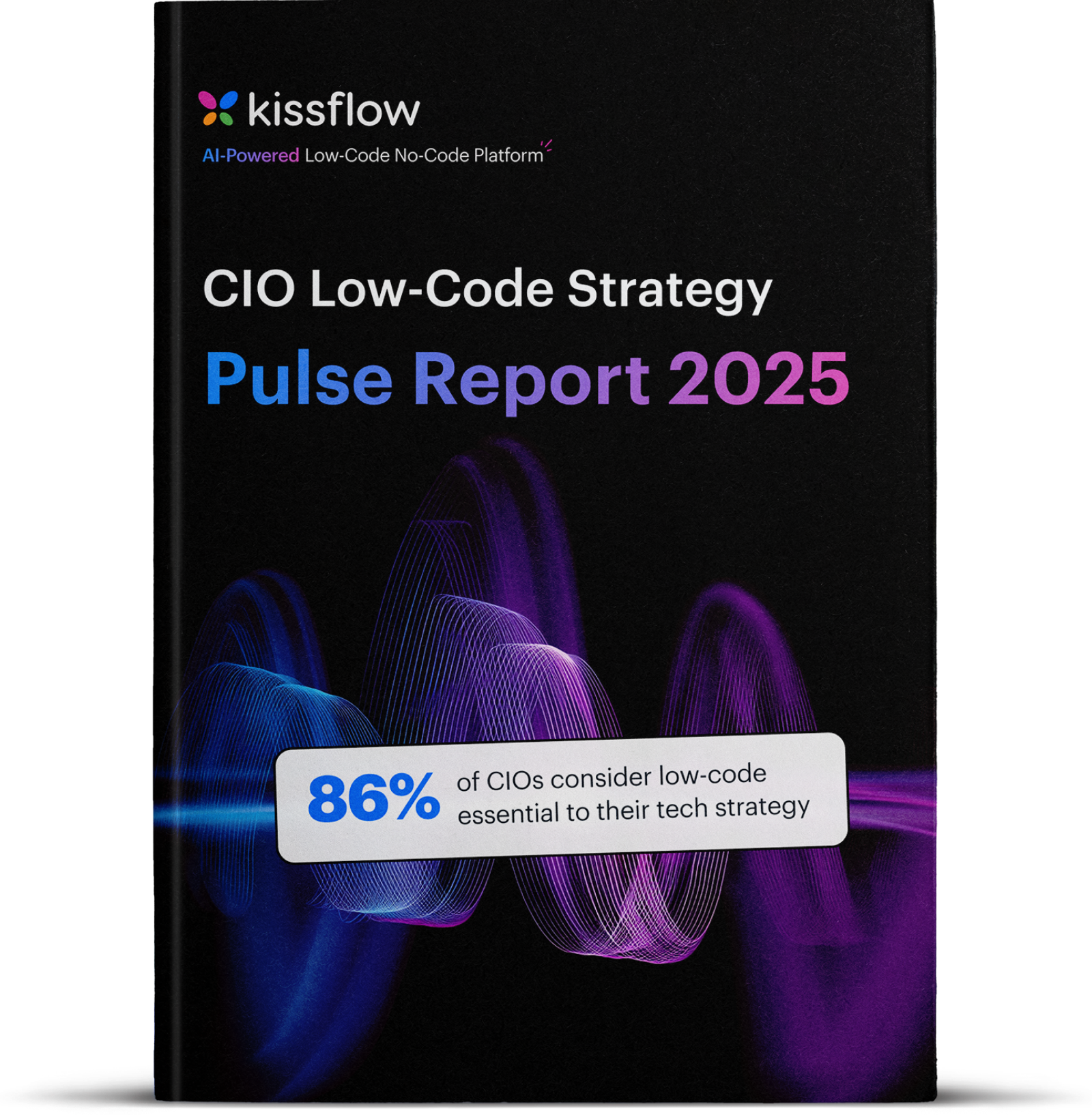
- >
- Workflow Platform >
- What is Workflow Automation? - A Complete Overview
What is Workflow Automation? - A Complete Overview
What if your team could stop drowning in repetitive tasks and focus on big wins? Workflow automation makes that possible. By replacing manual processes with automated workflow management, businesses are not just saving time-they're unlocking productivity, minimizing errors, and setting the stage for more intelligent decision-making.
Whether you’re dealing with IT bottlenecks, slow approvals, or endless data entry, a workflow management system transforms these pain points into opportunities for growth.
Ready to learn how workflow automation can change the way your business works? Let’s look into everything you need to know about workflow automation, from its benefits to overcoming challenges and best practices for success.
What is workflow automation?
Workflow automation involves the use of a workflow automation software that automates manual repetitive tasks and makes work faster, easier, and more reliable. It is an approach to making the flow of tasks, documents and information across work-related activities perform independently without human-intervention.
Companies adopt workflow automation tools to minimize manual work and automate repetitive tasks. This can include tasks like sending automated emails, managing customer data, or even streamlining new hire integration through an HR onboarding app.
To truly harness the power of workflow automation, organizations should invest in the right business workflow management software to streamline processes and drive efficiency at scale.
What is enterprise workflow automation?
Enterprise workflow automation helps businesses streamline repetitive tasks, reduce manual errors, and accelerate approvals across departments with minimal human intervention in a large scale.
- Chris Gardner, VP, Research Director at Forrester
Notably, 78 percent [1] of business leaders report that automation has significantly increased organizational productivity.
Learn more: Enterprise automation software
Why do you need to automate workflows for internal operations?
Automating workflows has become a cornerstone for organizations aiming to improve efficiency and reduce operational burdens. By replacing manual processes with automated ones, businesses unlock numerous advantages—from streamlined task execution to fewer human errors—that drive productivity, accuracy, and growth.
Implementing tools like an automated expense management system is a prime example, helping teams manage reimbursements, approvals, and reporting with ease. With the right tools, workflow process automation can transform complex business operations into efficient, rule-based systems that boost productivity and transparency.
Benefits of workflow automation system
Some of the main benefits of workflow automation process for businesses are as follows,
- Time savings
- Improved accuracy
- Enhanced collaboration
- Process transparency
- Increased productivity
- Faster decision making
- Consistency and compliance
- Cost efficiency
1. Time savings
A workflow automation system eliminates the delays caused by repetitive, manual tasks, allowing businesses to operate more efficiently.
For example, instead of manually processing invoices, an automated workflow can route them directly to the appropriate approver, send reminders, and schedule payments once approved.
This approach of automated workflows accelerates the process and reduces the likelihood of bottlenecks.Statistics quote that businesses save an average of 15-20 hours per week [2] per employee by automating routine workflows.
2. Improved accuracy
Manual processes are prone to errors, such as data entry mistakes, missed deadlines, or misfiled documents. A workflow platform minimizes these risks by standardizing tasks and applying error-checking mechanisms.
3. Enhanced collaboration
Teams often face challenges in maintaining alignment due to poor communication or a lack of transparency. A workflow orchestration platform bridges these gaps by providing real-time updates, shared dashboards, and automated notifications.
For example, in project management, automation tools keep all stakeholders informed of deadlines, changes, and task progress, ensuring that teams work cohesively toward shared goals.
4. Process transparency
A workflow automation system tracks every task and decision point, creating an auditable trail. Due to this level of transparency, organizations can pinpoint inefficiencies, improve accountability, and ensure compliance with industry regulations.
For example, in procurement, automated workflows provide visibility into vendor approvals, purchase requests, and payment statuses, enabling better oversight and control.
5. Increased productivity
Automating repetitive tasks allows employees to focus on more meaningful and strategic work. For instance, customer service teams can automate ticket assignments and status updates, allowing agents to dedicate more time to resolving complex customer issues rather than managing administrative tasks.
This adoption of workflow automation system not only boosts productivity but also enhances job satisfaction.
-> Learn more about workflow optimization tools
6. Faster decision-making
Automation provides real-time data and insights, enabling quicker and more informed decision-making.
For example, marketing teams can use digital automated workflows to analyze campaign performance in real-time, adjust budgets, and optimize strategies instantly rather than waiting for manual reporting. This agility is essential in competitive markets.
7. Consistency and compliance
Automated workflow application ensure that processes are followed consistently across the organization. This standardization is critical in industries with strict compliance requirements, such as healthcare and finance.
For example, healthcare providers can use automation to update patient records accurately and consistently, reducing the risk of compliance violations or legal issues.
8. Cost efficiency
Although not always highlighted, cost savings are a significant benefit of workflow optimization tools. Businesses save on operational expenses by reducing manual labor, preventing errors, and improving resource allocation.
Streamline your tasks with the power of workflow automation software.
Workflow automation statistics and trends
Here are some key statistics and figures of industries that benefited from workflow automation:
-
417% increase in revenue: Process and marketing automation yields a 417% increase in revenue.
-
$270 million annual savings: Cisco Systems automated its CRM process, eliminating 75,000 customer calls per month and saving over $270 million annually in operating expenses.
Key Areas of Anticipation: Businesses anticipate workflow automation in three areas: managing cost efficiency, improving time to market, and optimizing customer self-service.
Read more: Capgemini’s research.
How workflow automation works for business?
A workflow automation process begins with a clear objective and ends with a process evaluation. Here are 5 steps involved in carrying out a workflow automation process.

1. Identify a repetitive process
Zero in on a process that could benefit from automation. Ask questions such as ‘Is it mature enough to be automated?’ or ‘Does the team approve of or insist on automation?’.
2. Define goals
The benefits of workflow automation can be varied - increased ROI, faster time-to-market, and increased team productivity. Clearly articulate your team’s expectations from automation.
3. Train the team
The success of workflow automation depends on the willingness of its stakeholders. Communicate its benefits to the process owners and encourage their feedback.
4. Design the workflow
Build the process in the workflow management tool. Create a form, define the workflow, and assign permissions and rules for each step and stakeholder.
5. Measure KPIs and ROI
The purpose of automation is not fully achieved until your business compares the difference it has made to the pre-existing processes measured through reports and data analytics.
-> Learn more about enterprise workflow management software
Workflow automation example use cases
Workflow automation finds extensive use across industries. Here are some workflow automation use cases,
1. Lead generation and management
2. Employee onboarding
3. Invoice processing
4. Contract approval and renewal
Lead generation and management
Prospective customers go through various stages, from awareness to action. In order to convert them, marketing and sales teams need to stay in step with qualified leads as they progress through the AIDA (awareness, interest, desire, action) funnel.
The lead generation workflow often involves pulling data from several data sources and acting on it with emails and phone calls, as well as offering specialized content. Many steps, such as data collection and email sequencing, can be automated and made more efficient.
Using workflow automation can enable teams to keep track of every detail without suffering dropped leads. It also helps them coordinate seamlessly and improve the effectiveness of their lead nurturing initiatives.
Employee onboarding
Onboarding new employees is a significant responsibility for human resources teams everywhere. It is critical not only to provide all the information and assistance a new employee requires but also to ensure that the experience remains consistent.
The process of employee onboarding requires attention to detail in aspects such as extending offer letters, getting requisite forms completed, taking employees through organizational culture and practices, helping them settle into the workplace, and so on.
In workflow automation, rather than the HR staff being responsible for hand-holding the new employee from one department to the next, the system can guide the new hire along the path and make sure they don’t have to fill out the same information on multiple forms constantly.
Invoice processing
Invoice processing is an exercise that is largely left to the accounts department and their manual efforts. However, this is also a process that can benefit from workflow automation.
From receipt of invoices to matching, routing, approvals, payments, reconciliation, and reporting, the process becomes more accurate and transparent with the use of workflow automation.
Contract Approval and Renewal
Legal and procurement teams lose track of contract expiration dates, leading to unfavorable auto-renewals or service interruptions. Manual contract tracking across multiple vendors is error-prone.
Workflow automation sends renewal alerts 90, 60, and 30 days before expiration, routes contracts to stakeholders for review, tracks approval status in real time, and archives signed documents automatically. Companies avoid missed deadlines and negotiate better terms with adequate preparation time.
Success metrics for automating workflows in Enterprises
To continuously evaluate the effectiveness of automation, track key metrics:
- Time savings: Reduction in task completion time.
- Cost reduction: Annual savings in operational expenses.
- Error rate: Percentage decrease in manual errors.
- Productivity metrics: Increase in high-value tasks completed per employee.
- Employee & customer satisfaction: Measured through surveys and feedback.
By using these metrics, businesses can ensure long-term efficiency, cost savings, and scalability—making workflow automation a high-ROI investment.
Challenges in workflow automation and how to overcome them
While workflow automation platforms offer transformative benefits, it's not without its hurdles. From resistance to change to technical integration issues, organizations often face challenges that can derail automation initiatives.
Addressing these obstacles earlier ensures a smoother implementation and maximizes the impact of automation.
1. Resistance to change
One of the biggest roadblocks to implementing a workflow automation or a software is resistance from employees. Teams accustomed to manual processes may feel uneasy about adopting new technology, fearing it might render their roles redundant or require significant learning effort.
For example, an HR department might hesitate to use an hr workflow automation tool for onboarding system if they perceive it as threatening their personal touch in the hiring process.
Overcoming this resistance requires clear communication about how automation complements their work, rather than replacing it, by freeing them to focus on higher-value tasks like employee engagement.
Solution: Conduct training sessions, highlight quick wins, and involve employees early in planning to gain buy-in.
2. Undefined processes
A workflow automation system cannot fix a broken process. Automation will only magnify the inefficiencies if workflows are poorly documented or inconsistent. For example, automating a chaotic procurement process with unclear approval hierarchies will lead to errors or bottlenecks.
Before automating workflows, organizations must clearly understand their workflows, including steps, responsibilities, and outcomes. Without this groundwork, automation can fail to deliver the desired results.
Solution: Map out existing workflows, identify inefficiencies, and refine processes before introducing automation. Tools like process mining software can help uncover bottlenecks.
3. Legacy system integration
Many businesses still operate with legacy systems. Integrating these older systems with newer automation platforms can be technically complex and resource-intensive.
For instance, a financial institution may struggle to connect its decades-old core banking software with a new workflow automation tool.
These integration challenges can lead to delays, higher costs, and frustrations during implementation. Additionally, mismatched systems can create data silos, where critical information remains isolated and inaccessible.
Solution: To ensure smooth connectivity, use automation platforms with robust integration capabilities, such as API support or pre-built connectors. Gradually phase out or modernize outdated systems when feasible.
4. Upfront investment
The initial cost of implementing workflow automation can be daunting, especially for small and medium-sized businesses. Costs include software licensing, hardware upgrades, employee training, and ongoing maintenance.
For instance, automating a supply chain process might involve investing in sensors, cloud storage, and advanced analytics software, straining budgets. Decision-makers may hesitate if the ROI isn't immediately apparent.
Solution: Start with smaller automation projects to demonstrate quick wins and ROI. Use these early successes to justify broader investments.
5. Data security concerns
Workflow automation systems handle sensitive data, including customer information, financial records, and employee details. Protecting this data from breaches, unauthorized access, or misuse is critical.
Additionally, organizations must comply with regulatory standards like GDPR, HIPAA, or CCPA, depending on their industry and location.
For example, a healthcare provider automating patient records must ensure the platform adheres to strict data security regulations to avoid legal repercussions.
Solution: Opt for automation platforms with built-in security features like encryption, access controls, and audit trails. Regularly update systems to patch vulnerabilities and ensure compliance with relevant regulations.
6. Incorporate user feedback
End-users interact with automated workflows daily, making their feedback invaluable for optimization. Gather insights through surveys, interviews, or monitoring usage patterns to identify pain points or additional needs.
For instance, employees using an automated travel expense workflow might request the addition of currency conversion for international travel. Incorporating this feedback improves the user experience and adoption.
Why it matters: User-driven improvements ensure workflows remain practical and relevant, leading to higher satisfaction and efficiency.
Automate workflows efficiently with Kissflow
Kissflow’s delivers everything businesses need to simplify operations and drive efficiency. Its powerful features ensure seamless adoption, robust performance, and alignment with digital transformation goals.
Our intuitive workflow automation software turns your ideas into powerful, custom solutions — without a single line of code. Watch productivity soar as tedious tasks become automated victories.
Solve your workflow challenges with Kissflow and optimize your team's productivity today!.
Why wait to transform your workflows?
FAQs on workflow automation
1. What is the definition of workflow automation?
Workflow automation is the process of using software to automatically complete repetitive tasks and business processes without human intervention.
It helps teams save time, reduce manual errors, and improve overall productivity by automating steps in a workflow like approvals, data entry, and notifications.
2. What are some examples of workflow automation processes?
Common workflow examples include:
-
Employee onboarding
-
Leave request approvals
-
Invoice processing
-
Purchase order approvals
-
Customer support ticket resolution
These workflows help streamline daily operations and improve consistency.
3. What is the difference between workflow automation and RPA?
Workflow automation focuses on automating a sequence of business processes using rule-based triggers in a structured workflow.
Robotic Process Automation (RPA) mimics human actions to perform tasks on a computer, like copy-pasting data between systems, often across unconnected apps.
4. How does AI improve workflow automation?
AI improves workflow automation by intelligently routing tasks based on content and priority, extracting information from unstructured documents, predicting potential bottlenecks before they impact performance, identifying patterns that trigger appropriate workflow actions without explicit programming, handling increasingly complex decision-making, and continuously learning from process execution to suggest improvements.
5. What industries benefit most from workflow automation?
Industries benefiting most from workflow automation include financial services (loan processing, compliance reporting), healthcare (patient scheduling, insurance verification), legal services (contract management, case processing), manufacturing (quality assurance, maintenance workflows), and government agencies (permit applications, citizen service requests).
Related Articles












